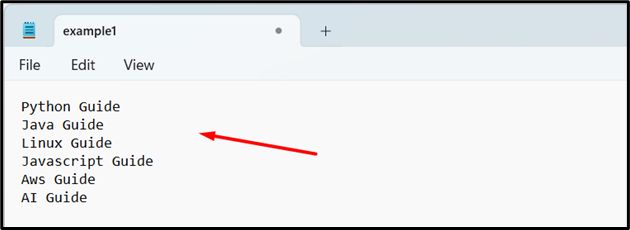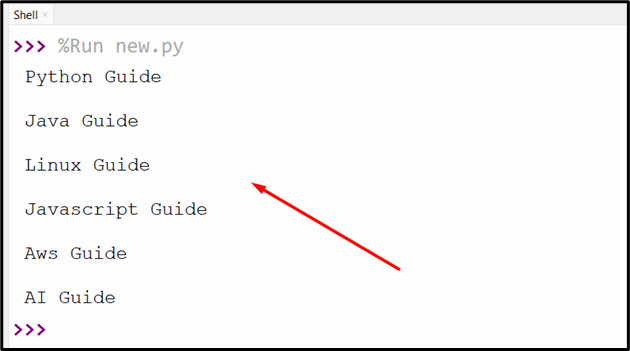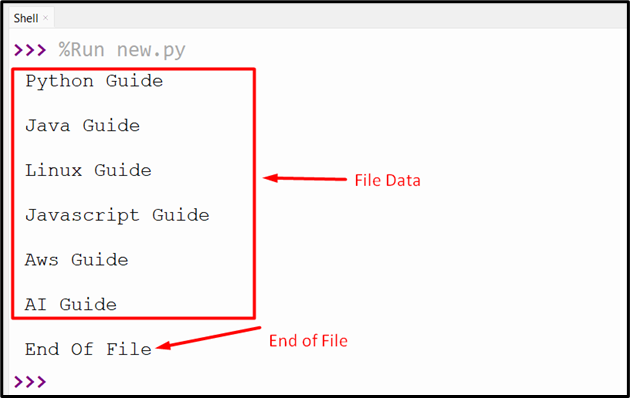While working with files, different operations are performed on it using a built-in Python module and method. Sometimes while working/dealing with files, we are required to read all the file’s data until the end for several reasons. The “file.readline()” method, “for loop” method, and others are used in Python to read all the lines of the given file until the end. The end of a file or stream indicates that there is no more data to be read.
This guide will give you a detailed overview of reading specified files line-by-line until the end via multiple methods. Here are the methods:
- Method 1: Using “file.readline()” Method
- Method 2: Using the “for” Loop
- Method 3: Using “file.readlines()” Method
- Method 4: Using the “while” Loop
- Method 5: Using the “strip()” Function
- How to Find the End of File in Python?
- Conclusion
Before moving toward the methods, let’s take a look at the sample file named “example.txt”:
Method 1: Read the File Line by Line Using “file.readline()” Method
To retrieve the file content line by line until the file ends, we use Python’s “file.readline()” method. This method takes the optionally specified size and retrieves the first line of the file. We can use this method multiple times or with a “while” loop to read the file until the end.
Syntax
Parameters
In the above syntax, the “size” parameter is optional. It specifies the size or integer value of the string that needs to be retrieved. The size parameter default value is “-1”, which will retrieve the entire string.
Return Value
The “file.readline()” method retrieves the line of the given file.
Example 1: Read the First Line of the Specified File
Here, we first open the file and read the first line using the “file.readline()” method. The “file.readline()” method does not take any value and retrieves the first line of the file. After reading, close the file.
print(file1.readline())
file1.close()
The first line of the file is shown below:
Example 2: Read the File Line by Line Until the End
We can use the file.readline() method multiple times to read the file until the end. But there are more appropriate and efficient ways of reading files line by line. To read the particular file line by line until the end we can use the “while” loop.
For example, in this code, we first opened the file and read it using the “readline()” method. After that, the while loop will retrieve the new line until the file ends. Here is the code:
file2 = file1.readline()
while file2:
print(file2)
file2 = file1.readline()
file1.close()
The output will look like this:
Method 2: Read the File Line by Line Using the “for” Loop
We can also read all the lines of the file utilizing the “for” loop. Let’s consider the file “example1.txt” which contains multiple lines of data. Next the “for loop” is used to loop through the file object and retrieve each line of the file. The file lines have been displayed in the output using the “print()” function and closed using the close() function.
for i in file1:
print(i)
file1.close()
All the lines of the given file have been displayed in the output:
Method 3: Read the File Line by Line Using “file.readlines()” Method
The “readlines()” method of Python can also be utilized to read the specified file line by line at once. This method removes the list that contains every new line as the list element. In the below code, the “file.readlines()” method applies to the file object “file1” and retrieves the list containing multiple lines.
print(file1.readlines())
file1.close()
The above code retrieves this:
Method 4: Read the File Line by Line Using the “while” Loop
The “while” loop can be used with the “readline()” method to read the specified file line by line. For instance, in this code, we first create the file object by opening the file. Next, the “while” loop is used with the “readline()” method to read all the lines until the content in the file is equal to empty. After reading all the file lines, we close the file using the “file.close()” method.
while file1:
z1 = file1.readline()
print(z1)
if z1 == "":
break
file1.close()
The below output shows that all the lines have been read until the end:
Method 5: Read the File Line by Line Using the “strip()” Function
We can also read the particular file line by line utilizing the strip() and “append()” functions along with the for loop. To understand it better let’s consider the file “example1.txt”. This file is opened in read mode utilizing the “open()” function. Next, we initialize the empty list to the “file_lines” variable. After that, the for loop iterates over the input file data and splits each line. Next, the append() method adds a new line to the empty list and displays it to output using the print() function.
file_lines = []
for x in f1:
x = x.strip()
file_lines.append(x)
print(file_lines)
The below snippet shows the list containing each line of the given file:
How to Find the End of File in Python?
Sometimes while reading the entire file lines or line by line until the end, we may be required to find the end of the file in Python. Let’s understand it by the below example.
Here, we first opened the file in read mode and provided the “True” flag to the variable. Next, the “while” loop is used with the “readline()” method to read every file line until the end of the file is reached. When the file end reaches the “flag” value is changed to “False”. When the flag changes the while loop exits and the file is closed.
flag = True
while flag:
file1 = file.readline()
print(file1)
if not file1:
print("End Of File")
flag = False
file.close()
The output of the above code looks like this:
Conclusion
The “file.readline()”, “for loop”, “file.readlines()”, “while loop” and “strip() with append()” methods are used to read the file line by line until the end. The “readline()” method when used without any loop will retrieve the first file line. When used with a loop such as “while” will retrieve all the file lines. We can also use the “for” loop alone to display all multiple lines of a specified file. This guide presented multiple methods with example code to read the file line by line.








